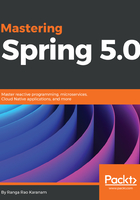
上QQ阅读APP看书,第一时间看更新
Architectural flexibility
Spring Framework is modular. It is built as a set of independent modules built on top of the core Spring modules. Most of the Spring modules are independent--you can use one of them without having to use others.
Let's look at a few examples:
- In the web layer, Spring offers a framework of its own--Spring MVC. However, Spring has great support for Struts, Vaadin, JSF, or any web framework of your choice.
- Spring Beans can provide lightweight implementation for your business logic. However, Spring can be integrated with EJBs as well.
- In the data layer, Spring simplifies JDBC with its Spring JDBC module. However, Spring has great support for any of your preferred data layer frameworks--JPA, Hibernate (with or without JPA), or iBatis.
- You have the option of implementing your cross-cutting concerns (logging, transaction management, security, and so on) with Spring AOP. Or, you can integrate with a fully fledged AOP implementation such as AspectJ.
Spring Framework does not want to be the jack-of-all-trades. While focusing on its core job of reducing coupling between different parts of the application and making them testable, Spring provides great integration with frameworks of your choice. This means you have flexibility in your architecture--if you do not want to use a specific framework, you can easily replace it with another.